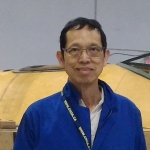 S. Khim Wong was born and grew up in Kuala Lumpur, Malaysia. He earned his bachelor degree in Mechanical Engineering from North East London Polytechnic/University of East London, England. His professional work experience started with Ford Motor Company in England and at British Gas Research Center. Returning to Malaysia in 1978 he worked for Tan Chong Motors/APM Holdings and started up a factory making car air conditioners. During this time, he traveled often to Japan for training and business.
S. Khim Wong was born and grew up in Kuala Lumpur, Malaysia. He earned his bachelor degree in Mechanical Engineering from North East London Polytechnic/University of East London, England. His professional work experience started with Ford Motor Company in England and at British Gas Research Center. Returning to Malaysia in 1978 he worked for Tan Chong Motors/APM Holdings and started up a factory making car air conditioners. During this time, he traveled often to Japan for training and business.
Khim joined the North American automotive industry in 1989 as plastic fuel tanks were beginning to replace steel tanks. At that time plastic fuel tanks were already commonly used in Europe and it was yet to be introduced in Japan. As emission limits for fuel vapour changed from 2 g/24hours to 0.2 and then to 0.054 g/24hours, the plastic fuel tank industry had to improve or die. He witnessed and participated in the evolution of the plastic fuel tank system and in 2003 he was a member of the team that won the Solvay Innovation Award for the development of a Fuel tank system that met the PZEV (0.054 g/24 hours) evaporative emission limit.
He has written a number of technical specifications including one published by The Society of Automotive Engineers International, SAE J2587 – Optimized Fuel Tank Closure, where he was chairman and co-author.
Khim was the first employee of his company to be posted to China in 2005. During the 5-year period, he established the supplier base and was the technical consultant and trainer. By 2016, his company has eight factories in China and India.
His work experience in Asia, Europe, and The Americas gave him a Global prospective of different work ethics and social cultures.
Keynote Speech
Quality of Life – A sum of many parts – of Cars, Life and an Aeroplane
This presentation aims to provide a glimpse of an Automotive Engineer’s view in the development of a motor vehicle and what it was like to work in the North American and Global automotive industry.
A car consists of about 30,000 parts. Different modules like the body, engine, transmission, seats, electrical, electronics ETC were assembled within 40 to 80 seconds at each assembly station.
In the design, development, testing and manufacturing, each car component must meet the functional and durability standards and requirements. Failures can result in costly production stoppage and recalls that can bankrupt a company.
A Fuel Storage and Delivery System is probably the most dangerous device we use every day. The fuel system and the dynamics of Filling, Storage, Gauging, Venting, Fuel Delivery, Vapour Management and Safety were explained.
Air pollution has harmful effects on human health. Pollution from burning fuel and fuel vapour are major contributors to air pollution problems. By 1990, the plastic fuel tank was already popular in Europe with about 80% market share, however in North America it had about 20% market share, and the plastic fuel tank industry faced a ‘death penalty’ when new emission regulations from California called for more stringent fuel vapour emission limits which technology of that time cannot meet. From 1992, new technologies were invented and evolved. Multi layer blow moulding, enhanced fuel tank system architecture and On-board Refueling Vapour Recovery (ORVR) system help to reduce evaporative emissions. By early 2000, it has gained about 80% market share.
The lessons learned from his first job at Ford Motor Company in England has the profound and lasting effect through out his professional life in Malaysia, the Americas, China and Europe.
